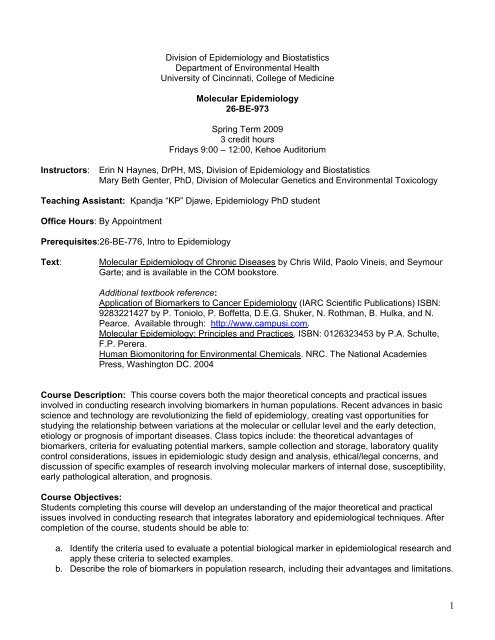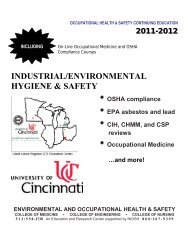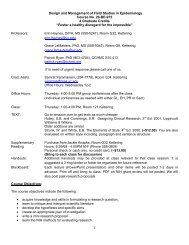Division of Epidemiology and Biostatistics Department of ...
Division of Epidemiology and Biostatistics Department of ...
Division of Epidemiology and Biostatistics Department of ...
Create successful ePaper yourself
Turn your PDF publications into a flip-book with our unique Google optimized e-Paper software.
<strong>Division</strong> <strong>of</strong> <strong>Epidemiology</strong> <strong>and</strong> <strong>Biostatistics</strong><br />
<strong>Department</strong> <strong>of</strong> Environmental Health<br />
University <strong>of</strong> Cincinnati, College <strong>of</strong> Medicine<br />
Molecular <strong>Epidemiology</strong><br />
26-BE-973<br />
Spring Term 2009<br />
3 credit hours<br />
Fridays 9:00 – 12:00, Kehoe Auditorium<br />
Instructors:<br />
Erin N Haynes, DrPH, MS, <strong>Division</strong> <strong>of</strong> <strong>Epidemiology</strong> <strong>and</strong> <strong>Biostatistics</strong><br />
Mary Beth Genter, PhD, <strong>Division</strong> <strong>of</strong> Molecular Genetics <strong>and</strong> Environmental Toxicology<br />
Teaching Assistant: Kp<strong>and</strong>ja “KP” Djawe, <strong>Epidemiology</strong> PhD student<br />
Office Hours: By Appointment<br />
Prerequisites:26-BE-776, Intro to <strong>Epidemiology</strong><br />
Text:<br />
Molecular <strong>Epidemiology</strong> <strong>of</strong> Chronic Diseases by Chris Wild, Paolo Vineis, <strong>and</strong> Seymour<br />
Garte; <strong>and</strong> is available in the COM bookstore.<br />
Additional textbook reference:<br />
Application <strong>of</strong> Biomarkers to Cancer <strong>Epidemiology</strong> (IARC Scientific Publications) ISBN:<br />
9283221427 by P. Toniolo, P. B<strong>of</strong>fetta, D.E.G. Shuker, N. Rothman, B. Hulka, <strong>and</strong> N.<br />
Pearce. Available through: http://www.campusi.com.<br />
Molecular <strong>Epidemiology</strong>: Principles <strong>and</strong> Practices. ISBN: 0126323453 by P.A. Schulte,<br />
F.P. Perera.<br />
Human Biomonitoring for Environmental Chemicals. NRC. The National Academies<br />
Press, Washington DC. 2004<br />
Course Description: This course covers both the major theoretical concepts <strong>and</strong> practical issues<br />
involved in conducting research involving biomarkers in human populations. Recent advances in basic<br />
science <strong>and</strong> technology are revolutionizing the field <strong>of</strong> epidemiology, creating vast opportunities for<br />
studying the relationship between variations at the molecular or cellular level <strong>and</strong> the early detection,<br />
etiology or prognosis <strong>of</strong> important diseases. Class topics include: the theoretical advantages <strong>of</strong><br />
biomarkers, criteria for evaluating potential markers, sample collection <strong>and</strong> storage, laboratory quality<br />
control considerations, issues in epidemiologic study design <strong>and</strong> analysis, ethical/legal concerns, <strong>and</strong><br />
discussion <strong>of</strong> specific examples <strong>of</strong> research involving molecular markers <strong>of</strong> internal dose, susceptibility,<br />
early pathological alteration, <strong>and</strong> prognosis.<br />
Course Objectives:<br />
Students completing this course will develop an underst<strong>and</strong>ing <strong>of</strong> the major theoretical <strong>and</strong> practical<br />
issues involved in conducting research that integrates laboratory <strong>and</strong> epidemiological techniques. After<br />
completion <strong>of</strong> the course, students should be able to:<br />
a. Identify the criteria used to evaluate a potential biological marker in epidemiological research <strong>and</strong><br />
apply these criteria to selected examples.<br />
b. Describe the role <strong>of</strong> biomarkers in population research, including their advantages <strong>and</strong> limitations.<br />
1
c. Describe the major problems in collecting, storing <strong>and</strong> processing various biological samples for<br />
human population studies, including principles <strong>of</strong> quality control for laboratory assays.<br />
d. Critically evaluate the major study designs used in molecular epidemiology, <strong>and</strong> describe the<br />
important issues to be addressed re: study validity <strong>and</strong> precision.<br />
e. Identify <strong>and</strong> describe the important ethical <strong>and</strong> legal issues involved in using human fluid or tissue<br />
specimens for research in an epidemiological context.<br />
f. Critically evaluate the use <strong>of</strong> biomarkers as indicators <strong>of</strong> the internal dose <strong>of</strong> exogenous<br />
substances such as environmental toxins <strong>and</strong> micronutrients.<br />
g. Describe the major challenges involved in studies using biomarkers as indicators <strong>of</strong> early<br />
pathological change, in the context <strong>of</strong> individual risk assessment or chemoprevention.<br />
h. Describe the major challenges involved in studies using biomarkers for early detection/screening<br />
or for evaluation <strong>of</strong> prognosis.<br />
i. Critically evaluate efforts to study the role <strong>of</strong> genetic variation in disease causation.<br />
j. Effectively synthesize & evaluate research to address a specific research question.<br />
Course Requirements:<br />
Blackboard: Blackboard will be used to share <strong>and</strong> discuss progress on the literature review, send<br />
course announcements, <strong>and</strong> post speaker slides <strong>and</strong> presentations. Because <strong>of</strong> the importance <strong>of</strong> each<br />
class session, each class will be videotaped <strong>and</strong> streamlined through Blackboard.<br />
Readings: For each lecture there will be selected readings to support the material presented. Reading<br />
the articles prior to the lecture will enhance the learning experience.<br />
Group discussion: There will be small group discussions at the end <strong>of</strong> each lecture. If you did not attend<br />
the class, you must respond to the discussion question on Blackboard for full participation credit.<br />
Literature Review: Each student will write a publishable review <strong>of</strong> the literature on the use <strong>of</strong> a<br />
biomarker(s) in a particular disease/organ system. The manuscript will be prepared according to<br />
specifications outlined by the journal you intend to submit the manuscript. Using the guidelines <strong>of</strong> the<br />
journal, your literature review will:<br />
1. Identify <strong>and</strong> describe the disease-exposure relationship<br />
2. Organize information <strong>and</strong> relate it to the research question you are developing<br />
3. Synthesize results into a summary <strong>of</strong> what is <strong>and</strong> isn’t known<br />
4. Identify gaps <strong>and</strong> controversy in the literature<br />
5. Use tables <strong>and</strong> /or figures to graphically represent data<br />
6. Develop questions for further research<br />
Papers should be submitted electronically through Blackboard. The journal specifications for a literature<br />
review should accompany your paper. The literature review will be due on the date <strong>and</strong> time scheduled<br />
for the final exam.<br />
Presentation: Each student will present their literature review to the class using PowerPoint.<br />
Presentations will be limited to 15 minutes. Assessment <strong>of</strong> presentations will be based on organization,<br />
subject knowledge, graphics, mechanics, eye contact, <strong>and</strong> elocution. The form used to evaluate the<br />
critique will be posted on Blackboard. Your presentations will be videotaped <strong>and</strong> made available on<br />
Blackboard for your review <strong>and</strong> personal critique.<br />
Grading Outline: Grading will be based on group discussion (30%), the literature review (40%), <strong>and</strong><br />
presentation (30%). There will be no exams.<br />
Academic Ethics: The faculty <strong>of</strong> the <strong>Department</strong> <strong>of</strong> Environmental Health believe that the conduct <strong>of</strong> a<br />
student taking a course in the <strong>Department</strong> should be consistent with that <strong>of</strong> a pr<strong>of</strong>essional individual. All<br />
2
students in this course will be expected to conduct themselves with complete integrity. All work by the<br />
student will be the work <strong>of</strong> that student, unless otherwise referenced.<br />
Course Outline by Week:<br />
Lecture Topic Chapter<br />
Readings<br />
Introduction / Study Design<br />
4/3/09 Course Introduction & Writing Literature Review Molecular<br />
Publishing a Paper<br />
<strong>Epidemiology</strong> Laboratory Overview & Sign-up<br />
2, 3, 15<br />
Speaker<br />
Dr. Erin Haynes<br />
Dr. Mary Beth Genter<br />
Molecular <strong>Epidemiology</strong> Study Designs<br />
4/10/09 Genetics in Molecular <strong>Epidemiology</strong><br />
Molecular Genetic Techniques<br />
IRB Issues<br />
Literature review topic <strong>and</strong> journal name due<br />
4/17/09 Data collection <strong>and</strong> h<strong>and</strong>ling<br />
DNA Collection, H<strong>and</strong>ling <strong>and</strong> Storage: Experiences from<br />
a Laboratory<br />
Biological Specimen Collection, H<strong>and</strong>ling <strong>and</strong> Storage<br />
4/24/09 Genetics in Molecular <strong>Epidemiology</strong> / Biomarkers in<br />
Translational Research<br />
Genetic Testing not Cost-Effective in Guiding Initial<br />
Dosing <strong>of</strong> Common Blood Thinner<br />
Molecular Genetics <strong>of</strong> Diabetes <strong>and</strong> SNPs vs Scans<br />
Introduction <strong>and</strong> Methods sections <strong>of</strong> literature review due<br />
5/1/09 Biomarkers for Screening <strong>and</strong> Early Detection<br />
Biomarkers for Alzheimer’s disease<br />
Epigenetic markers <strong>of</strong> Colon Cancer<br />
5/8/09 Biomarkers <strong>of</strong> Environmental Tobacco Smoke<br />
Racial Differences In Biomarkers <strong>of</strong> ETS<br />
Molecular techniques for ETS analysis<br />
Results section <strong>of</strong> literature review due<br />
5/15/09 Biomarkers <strong>of</strong> Lead Exposure<br />
Markers <strong>of</strong> Allergy <strong>and</strong> Asthma<br />
Discussion section <strong>of</strong> literature review due<br />
5/22/09 Student presentations<br />
5/29/09 Student presentations<br />
6/5/09 Student presentations<br />
11, 22<br />
7<br />
4, 5, 20<br />
10<br />
9<br />
26<br />
Dr. Carreon-Valencia<br />
Dr. Mary Beth Genter<br />
Dr. Erin Haynes<br />
Dr. Michael Spigarelli<br />
Dr. Erin Haynes<br />
Dr. Mark Eckman<br />
Dr. Deka<br />
Karen Putnam<br />
Dr. Ho<br />
Dr. Steve Wilson<br />
Dr. Michael Borchers<br />
Dr. Kim Dietrich<br />
Dr. Patrick Ryan<br />
3





![[3] Categorical Data Analysis, Alan Agresti, 2002, John Wiley.](https://img.yumpu.com/44435591/1/190x245/3-categorical-data-analysis-alan-agresti-2002-john-wiley.jpg?quality=85)




